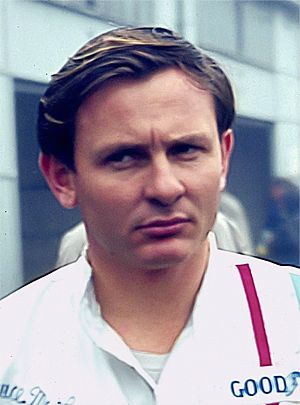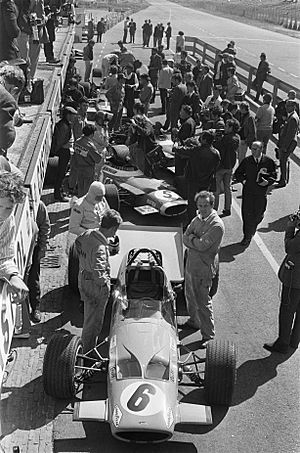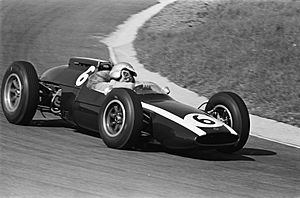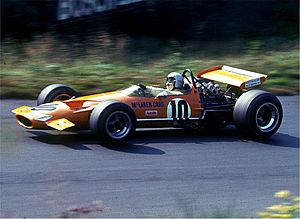Bruce McLaren facts for kids

Bruce McLaren in 1966
|
|||||||||||
| Born | Bruce Leslie McLaren 30 August 1937 Auckland, New Zealand |
||||||||||
|---|---|---|---|---|---|---|---|---|---|---|---|
| Died | 2 June 1970 (aged 32) Goodwood Circuit, Sussex, England, UK |
||||||||||
| Formula One World Championship career | |||||||||||
| Nationality | |||||||||||
| Active years | 1958–1970 | ||||||||||
| Teams | Cooper, McLaren, Eagle | ||||||||||
| Entries | 104 (100 starts) | ||||||||||
| Championships | 0 | ||||||||||
| Wins | 4 | ||||||||||
| Podiums | 27 | ||||||||||
| Career points | 188.5 (196.5) | ||||||||||
| Pole positions | 0 | ||||||||||
| Fastest laps | 3 | ||||||||||
| First entry | 1958 German Grand Prix | ||||||||||
| First win | 1959 United States Grand Prix | ||||||||||
| Last win | 1968 Belgian Grand Prix | ||||||||||
| Last entry | 1970 Monaco Grand Prix | ||||||||||
|
|||||||||||
Bruce Leslie McLaren (30 August 1937 – 2 June 1970) was a New Zealand racing car designer, driver, engineer, and inventor.
His name lives on in the McLaren team which has been one of the most successful in Formula One championship history, winning a total of 8 World Constructors' Championships and 12 World Drivers' Championships. McLaren cars dominated CanAm sports car racing with 56 wins, a considerable number of them with him behind the wheel, between 1967 and 1972 (and five constructors' championships), and have won three Indianapolis 500 races, as well as the 24 Hours of Le Mans and 12 Hours of Sebring.
Contents
Early life
Born in Auckland, New Zealand, Bruce McLaren attended Meadowbank Primary School. As a nine-year-old, he was diagnosed with Perthes disease in his hip that left his left leg shorter than the right.
His parents, Les and Ruth McLaren, owned a service station and workshop in Remuera Rd, Remuera, Auckland; Les McLaren had been a motorcycle racing enthusiast, but gave that up due to an injury before Bruce's birth, and began racing cars at the club level instead. Bruce spent all of his free hours hanging around the workshop and developed his passion during his formative years.
Career
Les McLaren restored an Austin 7 Ulster, which 14-year-old Bruce used in 1952 when he entered his first competition, a hillclimb. Two years later, he took part in his first real race and showed promise. He moved up from the Austin to a Ford 10 special and an Austin-Healey, then a Formula Two (F2) Cooper-Climax sports racing car. He immediately began to modify, improve and master it, so much so that he was runner-up in the 1957–58 New Zealand championship series.
McLaren founded McLaren Automotive in 1963.
Driving career
Grand Prix

His performance in the New Zealand Grand Prix in 1958 was noticed by Australian driver Jack Brabham (who would later invite McLaren to drive for him). Because of his obvious potential, the New Zealand International Grand Prix organisation selected him for its 'Driver to Europe' scheme designed to give a promising Kiwi driver year-round experience with the best in the world. McLaren was the first recipient, to be followed by others later including Denny Hulme. McLaren went to Cooper and stayed seven years. He raced in F2 and was entered in the German Grand Prix at the Nürburgring in which F2 and F1 cars competed together. He astounded the motor racing fraternity by being the first F2, and fifth overall, in a field of the best drivers in the world.
McLaren joined the Cooper factory F1 team alongside Jack Brabham in 1959 and won the 1959 United States Grand Prix at age 22 years 104 days, becoming the youngest ever GP winner (not including the Indianapolis 500) up to that time. This record would stand for more than four decades until Fernando Alonso's victory at the 2003 Hungarian Grand Prix. He followed that with a win in the Argentine Grand Prix, the first race of the 1960 Formula One season, and he would finish runner-up that season to Brabham.
McLaren won the 1962 Monaco Grand Prix, eventually finishing a fine third in the championship that year. The next year, he founded Bruce McLaren Motor Racing Ltd, which remains in the Formula One championship simply as McLaren. McLaren continued to race and win in Coopers (including the New Zealand GP in 1964).
McLaren left Cooper at the end of 1965, and announced his own GP racing team, with co-driver and fellow Kiwi Chris Amon. Amon left in 1967 to drive for Ferrari. In 1968, McLaren was joined by another fellow Kiwi Denny Hulme, who had become world champion in 1967 with Brabham. McLaren took his fourth career win racing his own McLaren car at Spa in 1968, achieving the team's first Grand Prix win. Hulme won twice in the McLaren-Ford.
The 1969 championship was also a success, with McLaren finishing third in the standings despite taking no wins. In tribute to his homeland, McLaren's cars featured the "speedy Kiwi" logo.
Can-Am series
McLaren's design flair and ingenuity were graphically demonstrated in powerful sports car racing. Just as the Can-Am began to become very popular with fans in Canada and the U.S., the new McLaren cars finished second twice, and third twice, in six races.
In 1967, they won five of six races and in 1968, four of six. The following year, McLarens proved unbeatable, winning all 11 races. In two races, they finished 1–2–3.
24 Hours of Le Mans
In 1965, McLaren and co-driver Ken Miles raced a Ford GT40 in the 24 Hour Race at Le Mans. The car was leading after 45 laps but retired due to gearbox failure. In 1966, McLaren and co-driver Chris Amon won the race in a Ford GT40, in a Ford 1-2-3 finish. The Ken Miles-Denny Hulme entry crossed the line first but travelled less distance due to the Le Mans style start.
Career as a constructor
McLaren was a competitive driver, but his legacy, the McLaren Racing Team, stems from his abilities as an analyst, engineer, and manager. In the early days of McLaren sports cars, McLaren was testing and as he drove out of the pits, he noticed the fuel filler access door was flapping up and down as he drove. The current aerodynamic thinking was that it should have been pressed more firmly in place as the speed of the car increased. Instead, it bounced more vigorously as the speed increased. Instantly, his frustration at the sloppy work changed and he had an insight. Stopping in the pits, he grabbed a pair of shears, and started cutting the bodywork away behind the radiator. Climbing back in the car, he immediately began turning lap times faster than before.
From that session came the "nostrils" that have been a key McLaren design feature, including in the McLaren P1 road car.
McLaren noticed that his team's cars were less innovative than the Chaparrals of rival driver/designer Jim Hall, but their superior reliability was rewarded by race and championship victories. That culture continued after his death and when Ron Dennis bought the team was reinforced by the lessons learned in his early career as a race mechanic.
Death
Bruce McLaren died aged 32 when his Can-Am car crashed on the Lavant Straight just before Woodcote corner at Goodwood Circuit in England on 2 June 1970. He had been testing his new McLaren M8D when the rear bodywork came adrift at speed. The loss of aerodynamic downforce destabilised the car, which spun, left the track, and hit a bunker used as a flag station.
Motorsport author Eoin Young said that Bruce McLaren had "virtually penned his own epitaph" in his 1964 book From the Cockpit.
McLaren was survived by his sisters Pat and Jan, wife Patty and daughter Amanda. He was buried at Waikumete Cemetery in Glen Eden.
Legacy
- The team Bruce McLaren founded in 1963 would continue on after his death and win 8 Constructors' Championships and 12 Drivers' Championships in Formula One.
- Bruce McLaren Intermediate School in West Auckland was named after him shortly after his death. It was originally going to be called Henderson South Intermediate. The school is on Bruce McLaren Road, in the suburb of McLaren Park.
- In 2015 the Taupo Motorsport Park in New Zealand was renamed Bruce McLaren Motorsport Park.
- In 2000, Motorsport NZ and the Prodrive Trust created the Bruce McLaren Scholarship to help up-and-coming New Zealand racing drivers.
- Inducted into the New Zealand Sports Hall of Fame in 1990.
- Inducted into the International Motorsports Hall of Fame in 1991.
- Inducted into the Indianapolis Motor Speedway Hall of Fame in 1991.
- Inducted into the New Zealand Motorsports Wall of Fame in 1994.
- Inducted into the Motorsports Hall of Fame of America in 1995.
- The Bruce McLaren Trust, based in Auckland, New Zealand, perpetuates his memory and runs a small museum, formerly located in the flat where Bruce grew up (above a petrol station in Remuera), now located at Hampton Downs Motorsport Park.
- On 20 January 2007, at New Zealand's round of the A1 Grand Prix series, it was announced that a movie was to be made about Bruce McLaren.
- On 21 February 2017 it was announced that Roger Donaldson would be making a movie called McLaren.
- The University of Auckland Formula SAE team use Bruce's racing number 47 as their car number in memory of Bruce.
- Inducted into the New Zealand Business Hall of Fame in 2022.
Film
The story of Bruce McLaren was told in the 2017 documentary film McLaren by Roger Donaldson.
Racing record
Complete Formula One World Championship results
(key) (Races in italics indicate fastest lap)
| Year | Entrant | Chassis | Engine | 1 | 2 | 3 | 4 | 5 | 6 | 7 | 8 | 9 | 10 | 11 | 12 | 13 | WDC | Pts. |
|---|---|---|---|---|---|---|---|---|---|---|---|---|---|---|---|---|---|---|
| 1958 | Cooper Car Company | Cooper T45 F2 | Climax Straight-4 | ARG | MON | NED | 500 | BEL | FRA | GBR | GER 5* |
POR | ITA | MOR 13 |
NC | 0* | ||
| 1959 | Cooper Car Company | Cooper T45 | Climax Straight-4 | MON 5 |
500 | NED | 6th | 16.5 | ||||||||||
| Cooper T51 | FRA 5 |
GBR 3 |
GER Ret |
POR Ret |
ITA Ret |
USA 1 |
||||||||||||
| 1960 | Cooper Car Company | Cooper T51 | Climax Straight-4 | ARG 1 |
2nd | 34 (37) | ||||||||||||
| Cooper T53 | MON 2 |
500 | NED Ret |
BEL 2 |
FRA 3 |
GBR 4 |
POR 2 |
ITA | USA 3 |
|||||||||
| 1961 | Cooper Car Company | Cooper T55 | Climax Straight-4 | MON 6 |
NED 12 |
BEL Ret |
FRA 5 |
GBR 8 |
GER 6 |
ITA 3 |
USA 4 |
8th | 11 | |||||
| 1962 | Cooper Car Company | Cooper T60 | Climax V8 | NED Ret |
MON 1 |
BEL Ret |
FRA 4 |
GBR 3 |
GER 5 |
ITA 3 |
USA 3 |
RSA 2 |
3rd | 27 (32) | ||||
| 1963 | Cooper Car Company | Cooper T66 | Climax V8 | MON 3 |
BEL 2 |
NED Ret |
FRA 12 |
GBR Ret |
GER Ret |
ITA 3 |
USA 11 |
MEX Ret |
RSA 4 |
6th | 17 | |||
| 1964 | Cooper Car Company | Cooper T66 | Climax V8 | MON Ret |
7th | 13 | ||||||||||||
| Cooper T73 | NED 7 |
BEL 2 |
FRA 6 |
GBR Ret |
GER Ret |
AUT Ret |
ITA 2 |
USA Ret |
MEX 7 |
|||||||||
| 1965 | Cooper Car Company | Cooper T73 | Climax V8 | RSA 5 |
9th | 10 | ||||||||||||
| Cooper T77 | MON 5 |
BEL 3 |
FRA Ret |
GBR 10 |
NED Ret |
GER Ret |
ITA 5 |
USA Ret |
MEX Ret |
|||||||||
| 1966 | Bruce McLaren Motor Racing | McLaren M2B | Ford V8 | MON Ret |
USA 5 |
MEX Ret |
16th | 3 | ||||||||||
| Serenissima V8 | BEL DNS |
FRA | GBR 6 |
NED DNS |
GER | ITA | ||||||||||||
| 1967 | Bruce McLaren Motor Racing | McLaren M4B | BRM V8 | RSA | MON 4 |
NED Ret |
BEL | 14th | 3 | |||||||||
| Anglo American Racers | Eagle T1G | Weslake V12 | FRA Ret |
GBR Ret |
GER Ret |
|||||||||||||
| Bruce McLaren Motor Racing | McLaren M5A | BRM V12 | CAN 7 |
ITA Ret |
USA Ret |
MEX Ret |
||||||||||||
| 1968 | Bruce McLaren Motor Racing | McLaren M7A | Cosworth V8 | RSA | ESP Ret |
MON Ret |
BEL 1 |
NED Ret |
FRA 8 |
GBR 7 |
GER 13 |
ITA Ret |
CAN 2 |
USA 6 |
MEX 2 |
5th | 22 | |
| 1969 | Bruce McLaren Motor Racing | McLaren M7B | Cosworth V8 | RSA 5 |
3rd | 26 | ||||||||||||
| McLaren M7C | ESP 2 |
MON 5 |
NED Ret |
FRA 4 |
GBR 3 |
GER 3 |
ITA 4 |
CAN 5 |
USA DNS |
MEX DNS |
||||||||
| 1970 | Bruce McLaren Motor Racing | McLaren M14A | Cosworth V8 | RSA Ret |
ESP 2 |
MON Ret |
BEL | NED | FRA | GBR | GER | AUT | ITA | CAN | USA | MEX | 14th | 6 |
* McLaren was ineligible to score points in the 1958 German Grand Prix because he was driving a Formula Two car.
Non-championship results
(key) (Races in bold indicate pole position) (Races in italics indicate fastest lap)
| Year | Entrant | Chassis | Engine | 1 | 2 | 3 | 4 | 5 | 6 | 7 | 8 | 9 | 10 | 11 | 12 | 13 | 14 | 15 | 16 | 17 | 18 | 19 | 20 | 21 |
|---|---|---|---|---|---|---|---|---|---|---|---|---|---|---|---|---|---|---|---|---|---|---|---|---|
| 1958 | Cooper Car Company | Cooper T45 | Climax Straight-4 | BUE | GLV | SYR | AIN 13 |
INT 9 |
CAE | |||||||||||||||
| 1959 | Cooper Car Company | Cooper T45 | Climax Straight-4 | BUE | GLV 6 |
AIN 3 |
INT Ret |
|||||||||||||||||
| Cooper T51 | OUL Ret |
SIL | ||||||||||||||||||||||
| 1960 | Cooper Car Company | Cooper T51 | Climax Straight-4 | BUE Ret |
GLV 4 |
|||||||||||||||||||
| Cooper T53 | INT 14 |
SIL 3 |
LOM | OUL 4 |
||||||||||||||||||||
| 1961 | Cooper Car Company | Cooper T53 | Climax V8 | LOM | GLV | PAU | BRX 2 |
VIE | SOL 4 |
KAN | DAN | MOD | FLG | OUL 3 |
LEW | VAL | RAN | NAT | RSA | |||||
| Cooper T55 | AIN 2 |
SYR WD |
NAP | LON | SIL Ret |
|||||||||||||||||||
| 1962 | Cooper Car Company | Cooper T55 | Climax V8 | CAP | BRX | LOM | LAV 1 |
GLV 2 |
PAU | AIN 2 |
INT 5 |
NAP | MAL | CLP 3 |
||||||||||
| Cooper T60 | RMS 1 |
SOL | KAN | MED | DAN | OUL Ret |
MEX Ret |
RAN | NAT | |||||||||||||||
| 1963 | Cooper Car Company | Cooper T66 | Climax V8 | LOM 4 |
GLV 2 |
PAU | IMO | SYR | AIN 5 |
INT 2 |
ROM | SOL | KAN | MED | AUT | OUL 6 |
RAN | |||||||
| 1964 | Cooper Car Company | Cooper T66 | Climax V8 | DMT 3 |
NWT Ret |
SYR | ||||||||||||||||||
| Cooper T73 | AIN Ret |
INT 15 |
SOL | MED | RAN | |||||||||||||||||||
| 1965 | Cooper Car Company | Cooper T77 | Climax V8 | ROC 5 |
SYR | SMT 4 |
INT 6 |
MED | RAN | |||||||||||||||
| 1967 | Bruce McLaren Motor Racing | McLaren M4B | BRM V8 | ROC Ret |
SPR 5 |
INT 5 |
SYR | OUL | ESP | |||||||||||||||
| 1968 | Bruce McLaren Motor Racing | McLaren M7A | Ford-Cosworth V8 | ROC 1 |
INT 2 |
OUL | ||||||||||||||||||
| 1969 | Bruce McLaren Motor Racing | McLaren M7B | Ford-Cosworth V8 | ROC Ret |
||||||||||||||||||||
| McLaren M7C | INT 6 |
MAD | OUL | |||||||||||||||||||||
| 1970 | Bruce McLaren Motor Racing | McLaren M14A | Ford-Cosworth V8 | ROC Ret |
INT 4 |
OUL |
Complete 24 Hours of Le Mans results
| Year | Team | Co-drivers | Car | Class | Laps | Pos. | Class pos. |
|---|---|---|---|---|---|---|---|
| 1959 | Cooper Monaco | S 2.0 | 79 | DNF | DNF | ||
| 1961 | Maserati Tipo 63 | S 3.0 | 31 | DNF | DNF | ||
| 1962 | Maserati Tipo 151 | E +3.0 | 177 | DNF | DNF | ||
| 1963 | Aston Martin DP214 | GT +3.0 | 59 | DNF | DNF | ||
| 1964 | Ford GT40 | P 5.0 | 192 | DNF | DNF | ||
| 1965 | Ford GT40X | P +5.0 | 89 | DNF | DNF | ||
| 1966 | Ford Mk.II | P +5.0 | 360 | 1st | 1st | ||
| 1967 | Ford Mk.IV | P +5.0 | 359 | 4th | 4th | ||
| 1969 | McLaren M6B | S 5.0 | - | DNA | DNA | ||
|
|
|||||||
Complete British Saloon Car Championship results
(key) (Races in bold indicate pole position; races in italics indicate fastest lap.)
| Year | Team | Car | Class | 1 | 2 | 3 | 4 | 5 | 6 | 7 | 8 | 9 | Pos. | Pts | Class |
|---|---|---|---|---|---|---|---|---|---|---|---|---|---|---|---|
| 1961 | Peter Berry Racing Ltd | Jaguar Mk II 3.8 | D | SNE | GOO 5 |
AIN 3 |
SIL 3 |
CRY | SIL Ret |
BRH 4 |
OUL 3 |
SNE 3 |
13th | 16 | 4th |
| 1965 | Nippon Racing | Isuzu Bellett | C | BRH | OUL | SNE | GOO DNS |
SIL | CRY | BRH | OUL | NC | 0 | NC | |
|
|
|||||||||||||||
Complete Tasman Series results
| Year | Chassis | 1 | 2 | 3 | 4 | 5 | 6 | 7 | 8 | Rank | Points |
|---|---|---|---|---|---|---|---|---|---|---|---|
| 1964 | Cooper T70 | LEV (3) |
PUK 1 |
WIG 1 |
TER 1 |
SAN Ret |
WAR 2 |
LAK (3) |
LON 2 |
1st | 39 (47) |
| 1965 | Cooper T79 | PUK Ret |
LEV (5) |
WIG 2 |
TER 2 |
WAR Ret |
SAN 4 |
LON 1 |
2nd | 24 (26) | |
| 1968 | BRM P126 | PUK Ret |
LEV Ret |
WIG 5 |
TER 1 |
SUR |
WAR |
SAN | LON |
6th | 11 |
Complete Canadian-American Challenge Cup results
(key) (Races in bold indicate pole position) (Races in italics indicate fastest lap)
| Year | Team | Car | Engine | 1 | 2 | 3 | 4 | 5 | 6 | 7 | 8 | 9 | 10 | 11 | Pos | Pts |
|---|---|---|---|---|---|---|---|---|---|---|---|---|---|---|---|---|
| 1966 | McLaren M1B | Chevrolet V8 | MTR 2 |
BRI 3 |
MOS Ret |
LAG 3 |
RIV Ret |
LVG 3 |
3rd | 20 | ||||||
| 1967 | McLaren M6A | Chevrolet V8 | ROA Ret |
BRI 2 |
MOS 2 |
LAG 1 |
RIV 1 |
LVG Ret |
1st | 30 | ||||||
| 1968 | McLaren M8A | Chevrolet V8 | ROA 2 |
BRI Ret |
EDM 2* |
LAG 5 |
RIV 1 |
LVG 6 |
2nd | 24 | ||||||
| 1969 | McLaren M8B | Chevrolet V8 | MOS 1 |
MTR 2* |
WGL 1 |
EDM Ret |
MDO 2 |
ROA 1 |
BRI 2 |
MCH 1 |
LAG 1 |
RIV Ret |
TWS 1 |
1st | 165 | |
|
|
||||||||||||||||
* Joint fastest lap.
See also
 In Spanish: Bruce McLaren para niños
In Spanish: Bruce McLaren para niños



